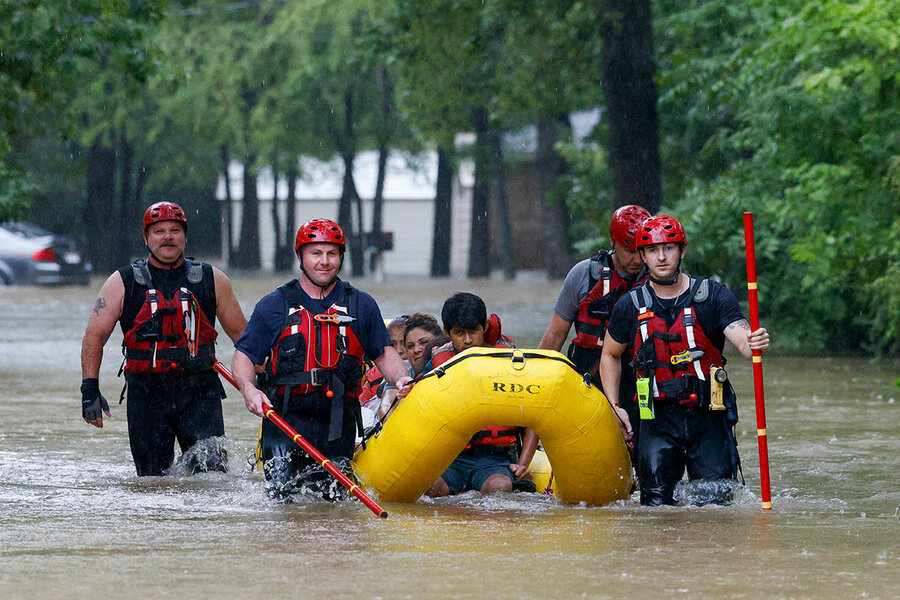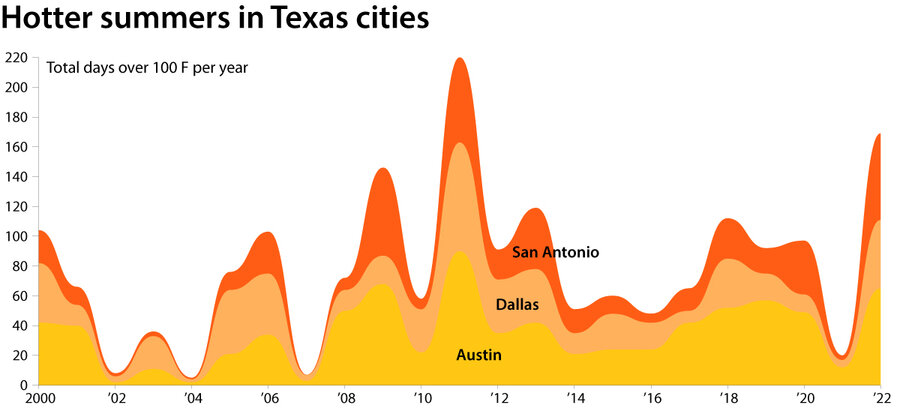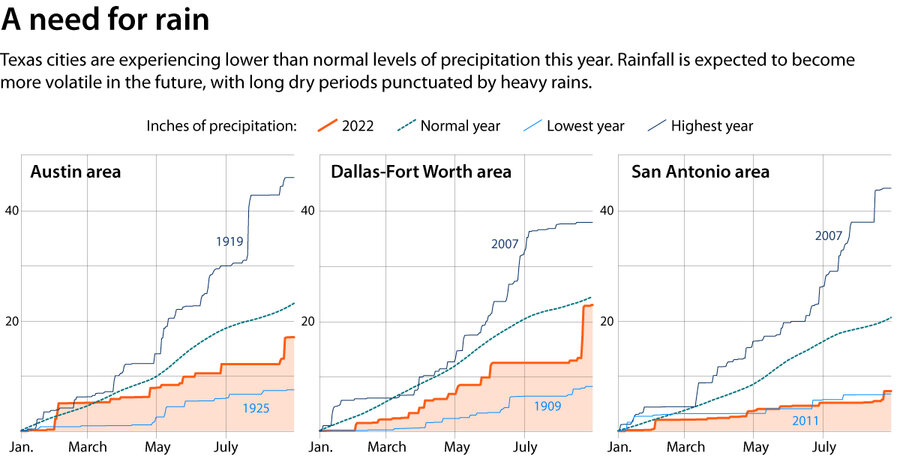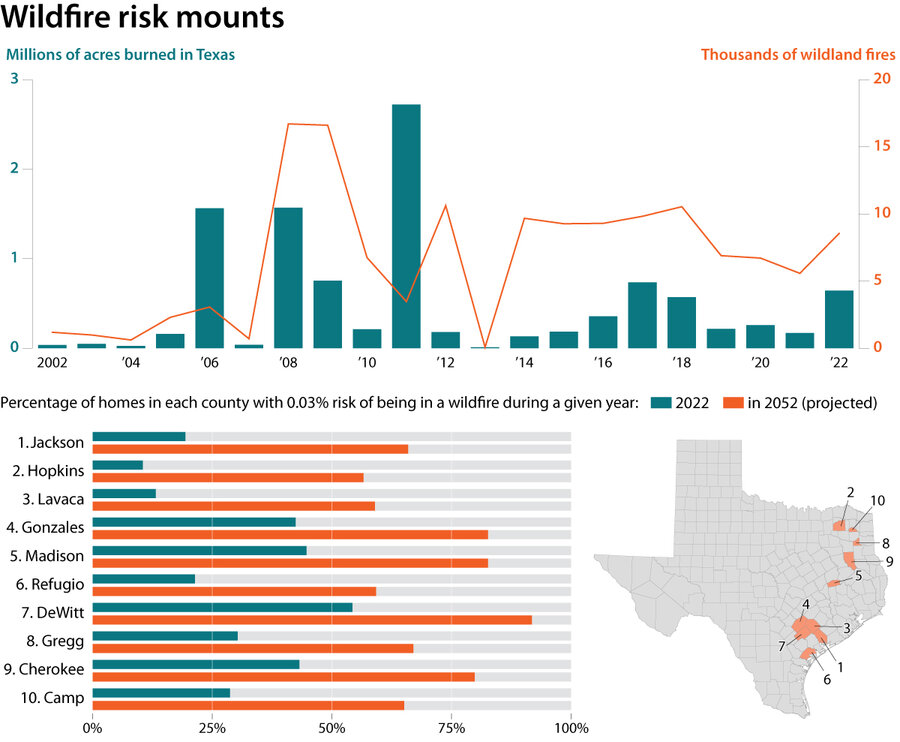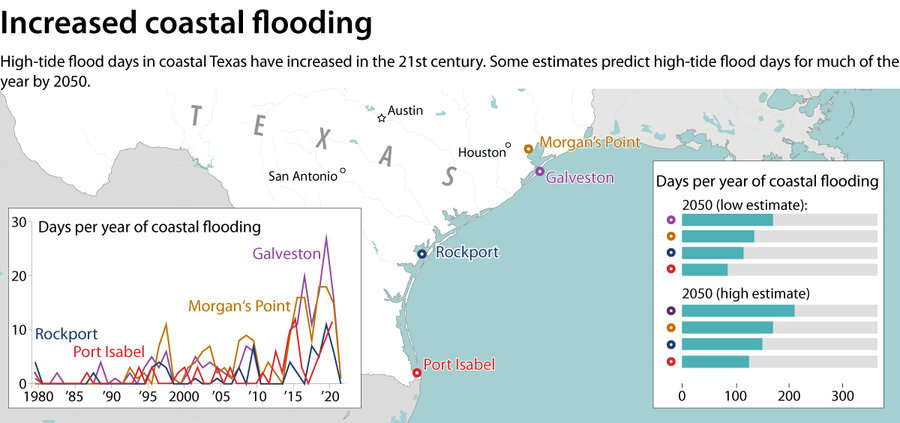Heat. Drought. Fires. Floods. Texas grapples with a new era.
Loading...
| Zapata, Smithville, and Galveston, Texas
This summer, Texas is feeling effects of climate change like never before.
Almost every corner has been experiencing extreme heat, and, until recently, often no rain. These patterns of heat and drought aren’t limited to Texas, but the trends here are noteworthy. The Lone Star State ranks second only to California in population and is among the fastest growing states. It’s a linchpin of the U.S. economy, from energy to tech. And as a solidly Republican red state, it’s a place where evolving views toward climate could have outsize political effects.
Why We Wrote This
A story focused onWhile climate change has not been a top political concern in Texas, it is increasingly emblematic of America’s climate change experience. From heat to damaging rains, this summer looks like a pivot point.
Already attitudes have been shifting. The share of Texans who believe climate change is currently harming people in the United States has risen from 50% in 2018 (slightly below the national average) to 60% last year (just above the national average), according to Yale Climate Opinion Maps.
This summer may be a preview of what scientists say could become normal conditions for the state. By 2036, there will be nearly twice as many 100-degree days as there are today, according to one study. Droughts are expected to become more severe, as are extreme rainfall events.
In the face of these challenges, Texans are demonstrating resiliency and innovation – from connecting local water services to cooperating with a nationwide wildfire response network.
When engineer Manuel Gonzalez moved back to his hometown of Zapata 20 years ago, the Texas community was in a major local drought. “It was their challenge [then]. It’s my challenge now,” he says.
Standing by the reservoir that serves as the town’s only water source, he shows the modest solution he’s been helping to build: A small structure of mud and rock, stretching a few feet into the Rio Grande-fed Falcon Lake Reservoir. At its edge he can pick up cellphone service from Mexico. More important, from it county pumps can access 15 feet of water – compared to 3 feet near the shoreline.
His effort is part of a transformation underway in a state that is feeling effects of climate change like never before.
Why We Wrote This
A story focused onWhile climate change has not been a top political concern in Texas, it is increasingly emblematic of America’s climate change experience. From heat to damaging rains, this summer looks like a pivot point.
Almost every corner of the state has been experiencing extreme heat, and, until recently, often no rain too. These patterns of heat and drought aren’t limited to Texas, but the trends here are noteworthy. The Lone Star State, after all, ranks second only to California in population and is among the fastest growing states. It’s a linchpin of the U.S. economy, from energy to tech. And as a solidly Republican red state, it’s a place where evolving views toward climate could have outsize political effects.
Already attitudes have been shifting. The share of Texans who believe climate change is currently harming people in the United States has risen from 50% in 2018 (slightly below the national average in that year) to 60% last year (just above the national average), according to Yale Climate Opinion Maps.
This summer may be a preview of what scientists say could become normal conditions for the state. By 2036, Texas’ bicentennial year, there will be nearly twice as many 100-degree days as there are today, according to a study last year by Texas A&M University and Texas 2036, a nonprofit, nonpartisan policy organization in the state. Droughts are expected to become more severe, as are extreme rainfall events. Meanwhile, population growth is projected to accelerate.
But in the face of these challenges, Texans have been demonstrating resiliency and innovation. From connecting local water services, to adapting the state’s water plan, to cooperating with a nationwide wildfire response network, the state is working to adapt to, and prepare for, a climate change-altered future.
Responding to severe drought
For almost a year, almost all of Texas has been in drought conditions, much of it extreme. In mid-August, 99% of the state was experiencing “abnormally dry” conditions, according to the U.S. Drought Monitor, with over 97% experiencing the two most severe categories of drought. If the drought persists, experts say it may rival 2011, the worst single-year drought recorded in state history.
In Zapata, the community of 14,000 has been caught between the Texas drought and a decadeslong drought in northern Mexico. Now the old Highway 83 is visible, 70 years after it was submerged by the Falcon Lake Reservoir.
The structure Mr. Gonzalez helped build is just one solution. The community has also interconnected four local water providers so they can share resources. In early August, they announced an agreement between U.S. and Mexican officials to dredge sections of the reservoir and increase water depth.
And Mr. Gonzalez, who runs a private engineering firm in south Texas, has been commissioned by the county to study potential secondary sources of water, including reusing wastewater. “We’re not there yet, but we are starting to look.”
That seems to be the trend. The 2011 drought was thought to be the kind you get twice a century.
“We’re having a drought [now] that looks very similar a mere 10 years after that 2011 drought,” says Robert Mace, a professor at Texas State University and executive director of the Meadows Center for Water and the Environment, in an interview earlier this month.
“We’ll be seeing drought conditions become a new normal for the state.”
Triple-digit temperatures on the rise
Heat and drought go hand in hand. As surface temperature increases, so does evaporation, and soil and foliage struggle to retain moisture.
The extreme heat this summer has been especially keen in Texas’ major cities. Both Austin and San Antonio had their hottest May on record, followed by their hottest June on record, followed by their hottest July on record.
Simultaneously, there has been very little rain. San Antonio is experiencing its worst year on record for rainfall. The Austin and Dallas areas went 52 and 67 days, respectively, without rain between June and August.
This is partly due to an ongoing climate pattern known as La Niña. This cyclical pattern sees cooler than normal surface temperatures in the equatorial Pacific Ocean push rainfall and cooler temperatures away from the southern U.S. While this La Niña has been relatively mild, according to Dr. Mace, it has also been long – projected to last for a rare third consecutive winter.
It’s unclear how climate change will affect La Niña, but it’s “very likely” that rainfall variability will significantly increase in the latter half of this century, according to the Intergovernmental Panel on Climate Change’s 2021 report. This summer Texas has had a preview of what that could look like.
A few weeks after snapping its 67-day rainless streak, Dallas experienced what’s been called a “one-in-a-thousand-year” flooding event. Over 9 inches of rain fell in 24 hours – more rain than the area typically sees in a whole summer – and caused as much as $6 billion in damages, according to an estimate from AccuWeather.
The Texas 2036 report on future climate changes in the state “not only pointed to increased future drought severity, but paradoxically a likely increase in future flood events,” says Jeremy Mazur, senior policy adviser on natural resources at Texas 2036.
The state’s surface temperature is predicted to be 3 degrees hotter by 2036, he adds. “What we’ll [then be] seeing is stronger peaks and longer valleys with regards to rainfall.”
Wildfires get harder to contain
One area where Texas – and the country – has shown great resilience and resourcefulness is in combating the growing threat of wildfire.
No two fire seasons are the same, but this year’s has been the busiest for Texas since 2011, with over 8,800 wildfires burning over 630,000 acres across the state. And risks are projected to grow as the state becomes hotter and more populated.
Assistance from thousands of firefighters from around the state and country, coordinated through a national interagency network, has helped minimize the recent damage.
Earlier this month, 56 of those firefighters gathered near Smithville, an hour west of Austin, to prepare for another day fighting the 700-acre Pine Pond Fire.
The previous day brought the county’s first significant rain in 52 days, but because it has been so dry, firefighters spend the morning patrolling fire lines for hazards that could reignite. They drive or walk over the charred landscape looking for “snags” – dead, standing trees that could be smoldering on the inside – and sniffing the air for “new” smoke (more pungent than “old” smoke).
Around noon, as the sun begins to pierce the clouds, four men from the Nacogdoches Fire Department hack their way toward a smoking log deep inside a section of unburned trees, surrounded by dry pine needles and leaves. It’s this kind of hazard they’ve been extinguishing all morning.
The men primarily fight structure fires, but in a normal year they go on one to three wildland fire deployments. This year they’ve had one or two deployments each month. They make short work of the log – scraping off the ash and dousing it in water – and head back out to look for the next problem.
Wildfires “are becoming more problematic to try to keep within the [containment] line,” says Steve Willingham, a resource specialist with the Texas A&M Forest Service and the senior incident commander for the Pine Pond Fire.
Yet wildfire response shows that statewide resources – nationwide resources, even – can be harnessed effectively when there’s a will to do so. “It keeps guys alive,” says Mr. Willingham. “It keeps people safe.”
Floodwaters and new defenses
The hope for rain varies by region in Texas. Travel east from dry Central Texas to the Gulf Coast’s emerald-green waters and it’s the persistent threat of flooding that grips researchers attempting to better understand the region’s future.
In August 2017, Hurricane Harvey dumped trillions of gallons of rainfall across metropolitan Houston and rural southeast Texas. The storm amounted to the second-costliest natural disaster in U.S. history, with $125 billion in damages – and a 2020 study in the journal Climate Change estimated that at least $30 billion of that was “attributable to the human influence on climate.”
It’s not just changes in the atmosphere that make climate change costly. It’s also the built environment, says Samuel Brody, a professor at Texas A&M University at Galveston and the director of the Institute for a Disaster Resilient Texas.
Focusing on the forces of nature, he says, “misses the whole idea of parking lots and rooftops and roadways and all this runoff we’re creating in downstream communities.”
In response, the institute recently launched a state-funded two-year project called Digital Risk Infrastructure Program, or DRIP. It partners with underserved Texas communities to solve flooding problems through data and analytical techniques.
The upshot: Communities like tiny Premont (an early DRIP partner, population 2,500) tell their flood stories, which inform the project’s solutions for mitigating future risks.
Among the state’s needs is defending against rising seas as well as heavier rains. Most ambitious among Texas climate-adaptation proposals is the proposed Dutch-inspired “Ike Dike,” named after the devastating 2008 hurricane that wiped out roughly 60% of structures on nearby Bolivar Peninsula and threatened Houston-area transportation routes. It was recently approved by Congress but funding remains to be approved.
Even if the dike system is built, big risks would remain. Galveston Island for example is gradually sinking even as sea levels also rise. Twenty years ago, Galveston witnessed roughly three annual high-tide flood days; last year, there were 14. By 2050, the island is projected to experience 170 such events per year, according to the National Oceanic and Atmospheric Administration.
“Nuisance flooding is going to start shutting down businesses,” says Bill Merrell, a marine sciences professor at Texas A&M University at Galveston, also a planner behind the Ike Dike. “If a parking lot’s occupied a third of the year with water, you’re not going to be able to function. You’ll have to adapt in some way.”




